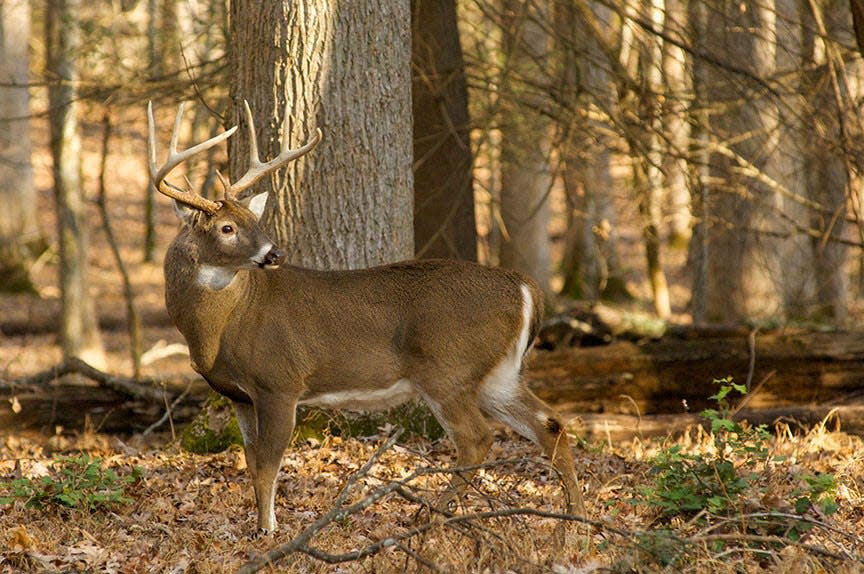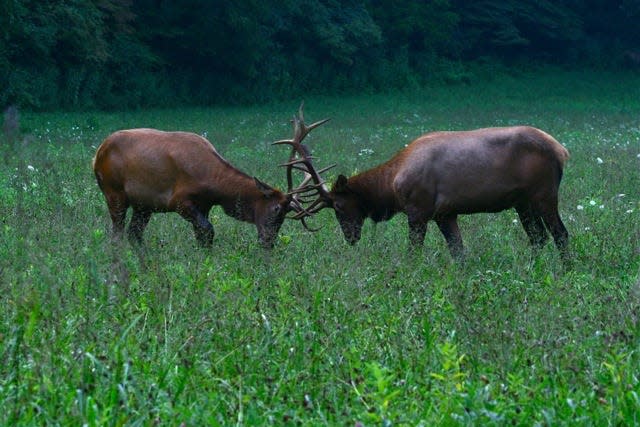Chronic wasting disease detected in NC deer: what hunters need to know
ASHEVILLE — A deer harvested in Johnston County, which is southeast of Raleigh, has tested positive for the highly transmissible chronic wasting disease, one of 11 known cases statewide, as reported by the North Carolina Wildlife Resources Commission on Oct. 13.
When a deer has this disease, an abnormal form of a protein found in the brain, called prions, accumulate in brain cells and eventually cause microscopic holes in the brain, leading to death, according to the wildlife commission. It takes 16 months for an infected animal to start showing signs of the disease, and once it does, the animal quickly loses body weight until it dies.
The 3 1/2 -year-old female white-tailed deer found with the disease in October was hunter-harvested during archery season, according to the news release. CWD is highly transmissible to other white-tailed and mule deer, as well as elk, and spreads through infected saliva, urine and feces of live deer, or by the movement of deer carcasses and carcass parts.
Though the Center for Disease Control states there have been no reported cases of CWD infections in people to date, the center says it is important to "keep agents of all known prion diseases from entering the human food chain.”

The most recent case closest to Western North Carolina was in Wilkes County in March of 2023, according to NCWRC. There have been no reported cases in Buncombe County, said wildlife commission spokesperson Anna Gurney.
However, Gurney told the Citizen Times by email, that “with more awareness of this disease and NCWRC’s outreach to the hunting community, NCWRC expects the state will experience an increase in reported cases.”
More: Don't eat anesthetized elk: New NC rule would forbid picking up elk carcasses
More: NC Wildlife proposes changes to fishing, hunting, trapping rules: What they say for WNC
What does the CWD detection mean for hunters?
“Now more than ever we need the cooperation of sportsmen and sportswomen,” Brad Howard, the commission's wildlife management division chief, said in the news release. “We need to continue to test as many hunter-harvested deer as possible to determine the distribution of CWD in our state and how many deer are infected.”
Howard stressed the importance of safely disposing deer carcasses, saying “the last thing we want to do is inadvertently move (the disease) to a new location.”
However, Howard said, hunting rules will not change this season for Johnston County, since open hunting season for archery already began Sept. 9 and making hunters aware of changes mid-hunting season is challenging.

More: Word from the Smokies: Broad-winged hawk migration coming soon
The NCWR recommends that whole deer carcasses and high-risk parts remain in Johnston County. The carcasses should also be taken to a processor or taxidermist participating in the commission's Cervid Health Cooperator Program for proper disposal and test submission. Hunters can find testing locations on NCWRC’s interactive map.
If the carcass is not taken to a Cervid Health Cooperator, hunters should follow one of the following disposal methods:
Bury the deer remains where the animal was harvested when possible.
Double bag deer remains for disposal at the closest landfill.
Leave the deer remains on the ground where the animal was harvested.
Low-risk carcass parts safe for transportation outside of Johnston County include:
Boned out meat
Caped hides
Antlers and cleaned skulls
Cleaned jawbones and teeth
Finished taxidermy products
Despite the detection of CWD in Johnston County, Gurney said the health of WNC’s deer population is “generally good.”
“The deer herd in Western North Carolina continues to increase, primarily on private lands where habitat is more favorable for deer,” Gurney told the Citizen Times.
According to the most recent estimate in 2020, Buncombe County has 11 to 20 deer per square mile. Henderson County was estimated at 21 to 30 deer per square mile and Madison County had 31 to 40, according to Gurney.
“As a result of the continued growth in the deer herds of WNC, the Wildlife Resource Commission has increased deer hunting opportunity over the last couple years in certain counties and will continue to look at additional increases to deer hunting opportunity, where appropriate,” Gurney said.
Western archery deer hunting season is now open for antlered deer through Nov. 19, then Dec. 10-Jan. 1. Gun season for deer in the mountains is open Nov. 20-Dec. 9, according to the wildlife commission's 2023-24 hunting regulations digest.
Ryley Ober is the Public Safety Reporter for Asheville Citizen Times, part of the USA Today Network. Email her at rober@gannett.com and follow her on Twitter @ryleyober
This article originally appeared on Asheville Citizen Times: What NC hunters need to know about deer with chronic wasting disease

